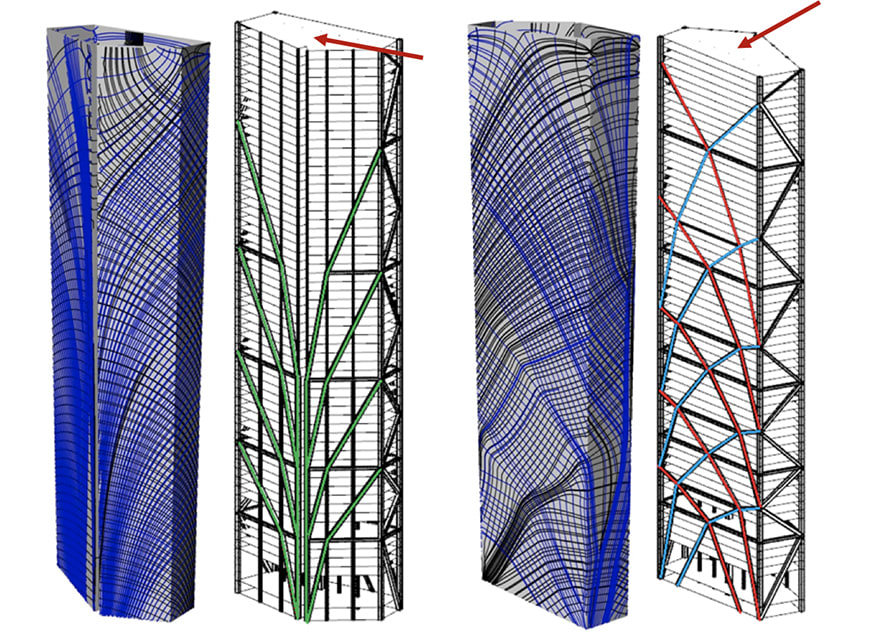Robert Bird Group pioneers automated design to improve structural design efficiencies on an office development in Sydney. Denise Chevin, editor of BIM+, finds out more.
New software written by the global engineering firm Robert Bird Group has enabled the firm to dramatically reduce the design time for a high-rise office tower in Sydney, Australia.
The building, circa 260m high at 55 storeys above ground level, has been designed by Foster & Partners.
The engineers have written a Grasshopper script which applies parametric design (computer generated design) to optimise the structural frame to get the most efficient design.
Using the script optimises the design of the frame so it does not need to be done manually, allowing two weeks’ work to be done in a day, explains Nick Cole, associate director at the Bird Group.
Rather than a conventional linear frame, the software produced organic framing patterns, which generate the most efficient forms of structures.
Cole says that the efficient external bracing design reduces the reliance on thick core walls around internal lifts as the outside structure supports the whole frame – which has offered back usable floor space and given the client significant cost savings.
The architect picked up on the organic patterns generated by the structural form finding process to provide an architectural identity to the building.

The internal lift core became a vertical load support only, able to be built from steel, or thin concrete walls
The building has a long-span (circa 20m) column-free internal floor space. The primary stability system is provided by the external steel bracing, which forms the primary identity of the building.
“The architectural concept for the external facade and the development of the structural design were intrinsically linked through this design process. The architectural team embraced the possibilities of generative design at an early stage and architects and engineers worked collaboratively to develop the building geometry.
“To demonstrate the highly collaborative approach to the design, and reinforce the innovative use of generative design processes, over half of the architectural competition presentation focused on the development of the structural design.”
The project started in the third quarter of 2017 and is due to be completed in 2021.
Cole says: “We are continually developing our approach to using parametric and optimisation tools within generative design scripts and have adopted a similar process on a number of live projects and competition entries since the initial development of the method on the Sydney building.”
The Robert Bird Group employs 600 employees across 10 offices and operates in five disciplines – structural engineering, civil engineering, geotechnical and virtual design and construction and construction engineering. Current projects in the London portfolio include 100 Bishopsgate and Phase 3 of Battersea Power Station.
Global projects include Dubai’s ICD Brookfield Place tower, Melbourne’s Australia 108 residential tower and Sydney’s One Central Park tower and Darling Harbour Live development.
In 2017 Bird became part of the global network of Singapore-based urban, industrial and infrastructure consulting business Surbana Jurong.
The design process in more detail
Robert Bird Group’s Nick Cole explains the design process in more detail.
“The design automation script was written using Grasshopper (within Rhino) to control the parametric structural geometry,” says Cole. “We then used a range of third party plug ins within Grasshopper to carry out topology optimisation and iterative structural finite element analysis to develop the optimised building geometry.”
Topology optimisation is an iterative structural analysis process, more commonly associated with the automotive and aerospace industries, that progressively adds material to highly stressed areas whilst removing material from areas of lower stress.
This analysis method typically results in organic structural forms, closely resembling geometric patterns that can be seen in nature, in a process often referred to as bio-mimicry, where nature has evolved to use materials in the most energy efficient form.
“The results of the topology optimisation identified efficient external bracing geometries whilst also identifying opportunities to reduce the density of the building structure towards the top of the building to maximise views over the harbour,” says Cole
“The limitations of the topology optimisation process are that it typically requires a high degree of manual interpretation to rationalise the organic output into a buildable structure. This contrasts with the highly automated parametric workflows that are typically used by RBG for these conceptual design studies.”
As such, RBG developed a second stage parametric structural analysis, using the results of the topology optimisation as a starting point and using genetic algorithms to optimise the structure further.
Genetic algorithms are another tool, used in parametric design, to allow many variables to be optimised simultaneously. This method simulates evolutionary natural selection (survival of the fittest) through an iterative process of promoting solutions that are close to meeting defined targets (fit individuals) whilst culling solutions that do not (unfit individuals).
The structural geometry resulting from this second stage analysis was benchmarked against a range of more conventional stability systems for tall buildings, including both externally braced frames and core and outrigger systems.
“The proposed steel framed design demonstrated a reduction in material usage, reduction in carbon footprint and increased structural performance over more conventional designs.
“Our optimisation process considered a range of target ‘goals’ during the analysis including both reducing material quantities for cost and sustainability benefits whilst also increasing building performance by reducing lateral movements at the top of the building,” says Cole.
Comments
Comments are closed.
















I suppose that, based on the structural bracing patterns obtained, the direction of the two applied tip loads in the figure is inverted.